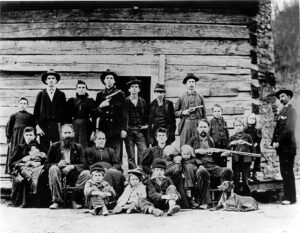
The Hatfield clan in the 1880’s. Armed and ornery. Was my daughter descended from this lot?
I suspect my daughter is a hillbilly. That is, I think she may have hillbilly blood running in her veins. How much hillbilly blood, you might ask?
Well, check this out. Her mother’s name is Marie Hatfield. Her grandfather’s name is Clarence. His father’s name was Floyd, and he was the son of a man named Valentine. That was his first name. Valentine Hatfield.
In 1888 a man named Valentine Hatfield was convicted of murdering Alifair McCoy, daughter of Randolph McCoy, during an attack on his home near Pikeville, KY. Valentine Hatfield was the brother of Devil Anse Hatfield, leader of the notorious feuding Hatfields. The feud started when Randolph McCoy accused one of the Hatfield clan of stealing his pig. The name of the Hatfield who allegedly stole the pig? Floyd Hatfield.
Now this doesn’t necessarily mean my daughter is a direct descendent of the feuding Hatfields but you must admit the coincidence seems awfully suspicious. It certainly did to me. Valentine and Floyd? I mean, come on. So I traveled to Pikeville, Kentucky to see if I could get to the bottom of it.
Complications of Blood
Pikeville is nestled in the rugged hill country of eastern Kentucky. It’s situated about 25 miles west of the Tug Fork, which is the border between Kentucky and West Virginia. To drive that distance, however, takes close to an hour because the road meanders through clustered hills for miles. Nothing runs straight here, least of all the bloodlines.
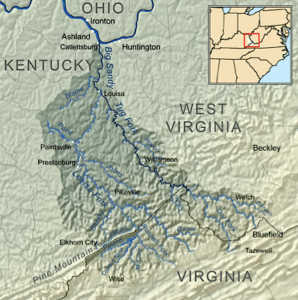
Hatfield and McCoy country, nestled in the remote corner of three states. Nothing runs straight here, least of all the blood lines.
When settlers first moved here in the 1820’s life was hard. The soil was too rocky to farm, so they lived off grazing stock, hunted small game and foraged. Only the most hardy hung on. By the 1860’s the number of families living in the area could be counted on two hands. So cousins marrying cousins was not uncommon, and when kin married outside the clan, they most often married into one of only a few other local families.
So even before the feud started the Hatfields and McCoys were mixed together by marriage, a complication of fidelity and blood that only served to heighten tensions when the battle lines were drawn in 1878 after Randolph McCoy noticed his missing pig in the sty of Floyd Hatfield. “That’s my hog,” he said. “No it ain’t,” said Floyd. And it was on.
A Hog Before the Law
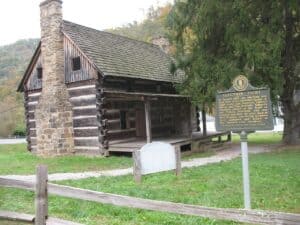
The cabin where the hog trial took place. It’s one of the few sites on the Hatfield and McCoy tour where there’s actually something to see.
Now you might expect, given the popular characterization of the feud, that the two sides began popping away at each other on the spot. But it was more civilized than that. In fact, the Hatfields and McCoys had a great respect for the law, something that is not surprising given the fact that they could pretty much predict the outcome of a trial based on how many family members were seated on a jury and which cousin or brother-in-law happened to be the judge.
That was what Randolph McCoy was counting on when he brought suit for recovery of his hog. After all, he had plenty of McCoys on the jury. The only problem was that he had brought suit on the West Virginia side of the Tug where “Preacher Anse” Hatfield was the judge. Testimony was taken from Bill Staton, a member of the Hatfield clan who swore the pig belonged to Floyd Hatfield and the matter was settled in the Hatfield’s favor.
Suspecting a fix, the McCoys were hopping mad and a few months later, after several violent run-ins, Bill Staton was gunned down during a skirmish in the woods. This matter, too, was brought before the law, and in an apparent attempt to mollify the injured parties, Valentine Hatfield (yes, that Valentine Hatfield) acting as judge, ruled the killing an act of self-defense and let the accused McCoys walk. The matter appeared to be at an end. But there were still hard feelings, and no one – I mean, no one – was about to kiss and make up.
Hatfields in Love
At the Pike County Tourism Bureau I purchased a book entitled simply, “The Hatfields.” It is a history of the feud backed by 150 pages of genealogical data on the Hatfield clan. Thumbing through it I was able to find a Floyd Hatfield born in 1878 who was the son of a Valentine Hatfield. Belle’s grandfather Clarence was born in 1936, which would’ve made Floyd 58 years old at the time of his birth. Way too old.
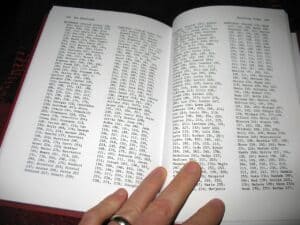
Geneaology of the Hatfields. It goes on for pages and pages like this. Somewhere in here was a thread that led directly to my daughter. Or so I hoped.
This particular Floyd Hatfield, however, had something interesting about him. He was married three times. In looking through the genealogy it appeared there was a lot of this going on. Hatfield men didn’t stay in relationships very long.
At a time when divorce was universally scorned, the Hatfields, it appears, took to it with gusto, and the number of flings, trysts and affairs they had seems remarkably high. The Hatfields loved love, it seems, and the most famous of such love affairs occurred between Johnse Hatfield and Roseanna McCoy, a real life Romeo and Juliet, if you believe some. On further analysis, however, you’ll see it was anything but.
A Hillbilly Lothario
Johnse and Roseanna met at a picnic in 1880 two years after the hog trial when feelings between the two families were still running high. It was love at first site. They couldn’t resist each other. In an act that would raise eyebrows even today, Roseanna left the picnic and returned home with Johnse and moved in with him. Needless to say, her father, Randolph McCoy, he of the stolen pig, was not pleased.
Randolph arranged to have Johnse arrested and hauled off to jail in Kentucky but Roseanna, in a stunning act of family disloyalty, reported the arrest to Devil Anse Hatfield, Johnse’s father, who rode over from West Virginia, intercepted the arresting party and freed Johnse under threat of violence. From that day on, Johnse kept his distance from Roseanna.
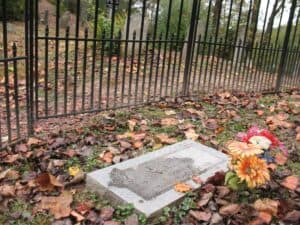
The grave of Roseanna McCoy in Pikeville. It was said she died of heartbreak, but her Romeo was a heel.
Roseanne was heartbroken. To make matters worse, she was pregnant with Johnse’s child and disowned by her family. Still, it wasn’t enough to make him go back to her. He was calling it quits and moving on. Romeo he was not. And then in an of act monumental insensitivity he turned around and married her cousin, Nancy McCoy, less than a year later, a union that apparently came off without fireworks, in spite of Johnse’s poor grasp of politics. Roseanna, for her part, died of heartbreak at age 29, or so the story goes.
Johnse, it’s worth noting, married three more times after that, a hillbilly Lothario if there ever was one, and yet another contributor to the tangled blood lines I was trying to sort out.
At this stage, I was no closer to untangling the scrambled lineage of my daughter’s heritage or even finding the thread to start with.
Mountain Justice
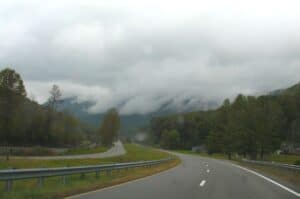
Mist in the mountains. I drove from Pikeville through the Tug River Valley along winding mountain roads.
The Pike County Tourism Bureau, housed in the Hampton Hotel in Pikeville, is working hard to develop the feud sites as a tourist draw. They offer maps, books, audio tapes and self-guided audio tours. The story of the feud is ever fascinating, but the sites themselves are mostly ho-hum.
I drove from Pikeville north through the Tug Valley and into West Virginia. I followed the map along winding mountain roads and stopped at the designated sites. With the notable exception of the log cabin where the hog trial took place, the sites are merely historical markers without much else to distinguish them. At the site where the Hatfield gang tied three of the McCoy brothers to Paw Paw trees and shot them, for example, no Paw Paw trees are currently growing, making it kind of hard to envision what happened there – and what happened there was high drama.
The Paw Paw tree killings were the Hatfield’s response to an incident that occurred four years after the hog trial, two years after the Johnse and Roseanna affair. It’s a measure of how close the two families were that, even with so much bad blood between them, they still got together for social events, and in 1882 one of the most popular social events of the season was election day.
People gathered at the election grounds to debate popular issues, celebrate electoral victories and get drunk. It was at the election grounds near Blackberry Creek in Kentucky that a drunken brawl broke out between the Hatfields and McCoys. In the melee Ellison Hatfield was stabbed in the back.
The three McCoy brothers responsible for the fracas were arrested, but Devil Anse Hatfield, never one to shy from confronting the authorities, seized the boys from the sheriff and took them across the Tug River into West Virginia. He held them captive as he awaited the fate of Ellison Hatfield who was still alive but hanging on by a thread. He told the McCoys that if Ellison lived, he would free the captives, but if he died, they would pay the price. He died. The three McCoy brothers were tied to the trees and shot. Mountain justice.
Cottontop Drops
The Paw Paw tree killings escalated the feud. Now the two sides could not see each other without hard looks, mean words and outbreaks of violence. It got so bad that it drew the attention of the governor of Kentucky who appointed a special officer to bring the murderers of the McCoy brothers to justice and end the feud. Bounty hunters descended on the region and spread out into West Virginia, looking for the Hatfields, which only served to incite more violence.
Finally, on New Years night 1888, the Hatfields, sick of being hunted and harassed, lashed out at the McCoys, hoping to end the feud by killing Randolph McCoy, head of the McCoy clan and the one man who could bring damning evidence against them. They raided Randolph’s cabin, attacking his wife and children, shooting his son and burning the cabin to the ground. Randolph got away. But Randolph’s crippled and unarmed daughter, Alifair, was killed.
This was the final straw. The authorities from Kentucky rode into West Virginia, shot two of the Hatfield gang and arrested nine others, including Valentine Hatfield, who ten years earlier had presided as judge in the trial of Bill Staton, which had acquitted the McCoys of murder. It bought him no leniency. Valentine and seven others were convicted and sentenced to life. The ninth, a young man named Ellison “Cottontop” Mounts, was condemned to be hanged.
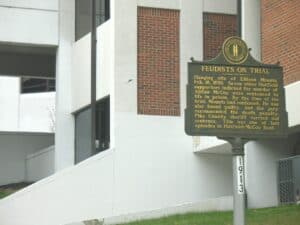
The site of the hanging today, the most anti-climactic of many anti-climactic sties on the self-guided driving tour.
The hanging of Ellison Mounts is widely considered to be a travesty, a bone thrown to the vengeful McCoys to appease them and bring the feud to an end. Mounts was a sacrificial lamb, a naïve half wit who probably didn’t understand what was happening to him. In any case, he was the one person condemned to die for all the bloodshed between the Hatfields and McCoys. Today the site of his hanging is a parking facility on the campus of Pikeville University, the most anti-climactic of many anti-climactic sites on the Hatfield and McCoy tour. I was a little disappointed that my effort to discover the lineage of my daughter had mostly floundered, but on the way home I decided to give my ex-wife a call, my daughter’s mother, to let her know what I’d been up to.
My Funny Valentine
It turned out Marie had a file folder full of all sorts of genealogical data relating to her family, much of it gleaned from the web, with notes in the margins indicating that whoever had compiled it was up to the same thing I had been up to, trying to connect her family to the feuding Hatfields, even going so far as to suggest that the Valentine Hatfield who died in prison in 1890 was her great-great-grandfather.
This was simply not possible as it meant her great-grandfather would had to have been born three years after his father died, which would’ve made for an unusually long pregnancy for his mother. No, the Valentine Hatfield of the feuding Hatfields was not our Valentine. So who was?
Marie made some calls to her sister and her father and we began to cobble it together. As it turned out, her grandfather Floyd was born in 1893 and came to Illinois from Hancock County, Kentucky, around 1920. Hancock County is about 250 miles west of Pikeville, a long way from feud country.
We knew Floyd’s father’s name was Valentine, but that wasn’t enough, and it kept leading us down a blind alley to the feudists. We needed something more and after a little digging around we found it, in the notes in her file. Floyd’s father went by the nickname of “Tine”, short for Valentine. As it turned out this was the key to the whole thing.
Branches on a Tree
Although it wasn’t in the genealogy book I bought in Pikeville, I googled the name Valentine “Tine” Hatfield and discovered, to my great surprise, a genealogical thread that identified him as being born in 1867 and coming from Hancock County, Kentucky. Although it didn’t list the names of his children, he was clearly the father of Floyd whose birth occurred in Hancock County in 1893 when Valentine “Tine” Hatfield was 26. The thread also provided the name of Valentine’s father. I clicked on the link.
Valentine was the son of Ephraim Hatfield who was born in Fentress County, Tennessee in 1826. There was a link to his father. I clicked on it. Ephraim was the son of James William Hatfield who was born in Tennessee in 1808. A link led me further back, to the name of his father.
John T. Hatfield was born in Russell County, Virginia in 1785 before the US constitution was ratified, and his father Joseph Hatfield was born in Augusta County, Virginia, on the eastern slope of the Appalachians in 1740, thirty-six years before the American Revolution!
Joseph Hatfield is especially interesting because he married twice. His second wife, Rachel Smith, produced the branch of the family from which my daughter is descended. His first wife, Elizabeth Vance, produced the branch from which the feuding Hatfields are descended.
So there it was. My daughter was not a direct descendant of the feuding Hatfields, but she was something more; she was a young woman with very deep roots in this country. That was exciting. I dug deeper.
The Pilgrim
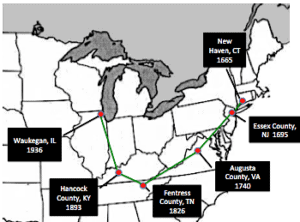
Migration route of the Hatfield family, from New Haven, CT to Waukegan, IL in 300 years. (Click image to enlarge)
Joseph was the son of Abraham Hatfield Jr. who was born in Essex County, New Jersey in 1695, and he was the son of Abraham Hatfield Sr. who was born in Elizabethtown, New Jersey in 1670, a mere 50 years after the pilgrims set foot on Plymouth Rock! Abraham Sr. was a shoemaker and ran a tannery with his brother. Industrious fellows for sure, and sons of a courageous father, Matthias.
Matthias Hatfield was the first Hatfield in twelve generations not born in America. He was born in Leyden, Holland in 1640. Records indicate that he married Maria Moylen in New Haven, Connecticut in the 1660’s. So he was the first Hatfield to come to the New World. He arrived just twenty-five years after the City of New Haven was founded by a party of Puritans moving down from Massachusetts Bay Colony. Those Puritans would’ve been on a first name basis with William Bradford and the original Mayflower settlers.
Presumably Matthias would’ve felt right at home among the Puritans because his father, Thomas Hatfield, was a religious dissenter who was born in Almondsbury, England in 1620 but left the country for Holland sometime in the late 1630’s, a pilgrim in his own right. Almondsbury, for the record, is 125 miles west of the town of Hatfield in England.
The Good Blood
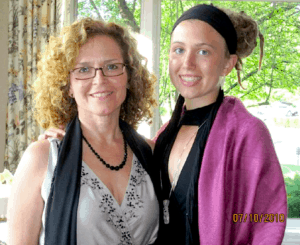
Marie Hatfield Logan and Cambelle Logan in 2010. They are descended from the good blood, which makes me glad.
Ha! So my daughter is not descended from hillbillies. Instead, she is descended from a long line of brave and industrious frontiersmen.
From the moment Thomas Hatfield set forth from England in the 1630’s this branch of the Hatfield’s have been on the move, going from Holland to Connecticut, from Connecticut to New Jersey, and from there on to Virginia, Tennessee, Kentucky and Illinois, where she was born in 1989. Today she lives in California. These Hatfields are voyagers, seekers and pioneers. They are the best of what it means to be an American.
So while it would’ve been thrilling to find a connection to the feuding Hatfields, what I found instead was even better, a brave, resilient people who never would’ve gotten bogged down in a feud over a stolen hog. Once things got ugly, they simply would’ve pulled up stakes and moved on. They are just the sort of people I admire, people true to their convictions, smart, resourceful, willing to take risks, and not likely to sit still for petty nonsense. I’m proud that their blood runs in my daughter’s veins. She has good blood.
Previous stop on the odyssey: Pigeon Forge, TN //
Next stop on the odyssey: Lexington, KY
Sources:
Descendants of Thomas Hatfield. Jennifer-Norman.com. Acquired 23 Nov. 2013.
Hatfield, G. Elliott. The Hatfields. Paintsville, KY: East Kentucky Press. 1974. Updated and revised 2012.
Pike County Tourism, Convention and Visitor Bureau, The Great Vendetta. 2013.
Wikipedia contributors. “Hatfield and McCoy Feud.” Wikipedia, The Free Encyclopedia. Wikipedia, The Free Encyclopedia, last modified 26 Nov. 2013. Acquired 27 Nov. 2012.
Image credits:
Hatfield clan, Public Domain; Devil “Anse Hatfield, West Virginia and Regional History Collection WVU Libraries; Cambelle Logan, Malcolm Logan; Hatfield and McCoy Region map, Kmusser; Hog trial cabin, Malcolm Logan; Randolph McCoy, McCoy Family Genealogy; Genealogy book, Malcolm Logan; Johnse Hatfield, Kentucky Genealogy; Roseanne McCoy, Public domain; Roseanna McCoy grave, Malcolm Logan; Mist in the Mountains, Malcolm Logan; Site of the Paw Paw trees killings, Forest McDermott; Hatfield homestead, Malcolm Logan; Ellison Cottontop Mounts, Pike County Tourism, Convention and Visitors Bureau; Ellison Cottontop Mounts Hanging, Pike County Tourism, Convention and Visitors Bureau; Mounts hanging site, Malcolm Logan; Valentine “Wall” Hatfield, Public domain; Hatfield street in Matewan, Malcolm Logan; Hatfield family tree, Malcolm Logan; Migration route of the Hatfields, Malcolm Logan; Marie Hatfield Logan and Cambelle Logan, Marie Hatfield Logan

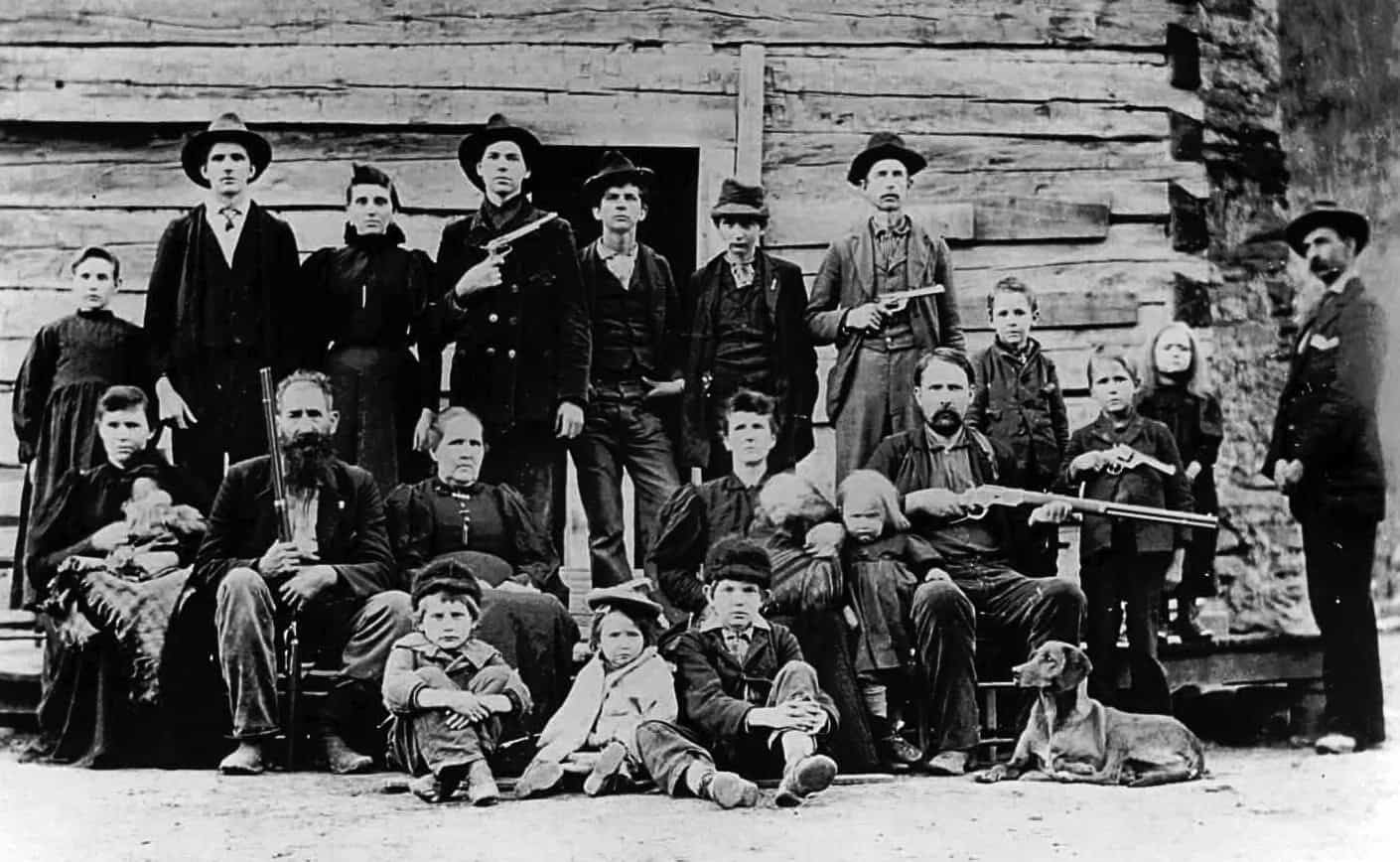
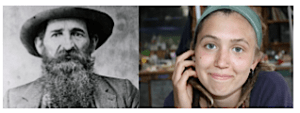
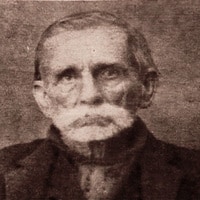
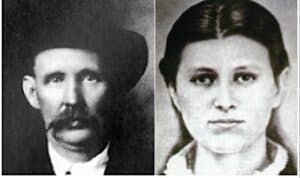
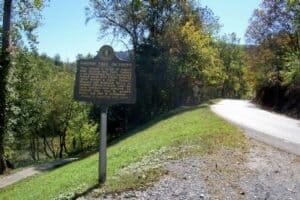
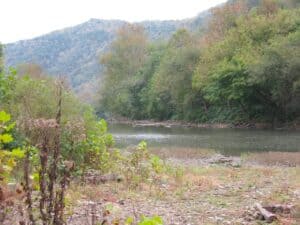
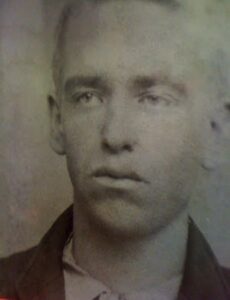
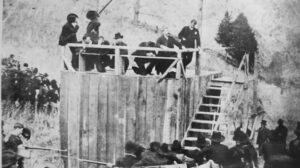
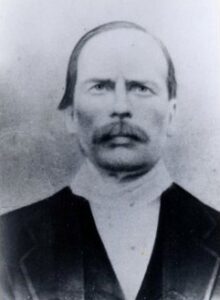
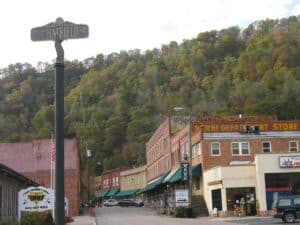
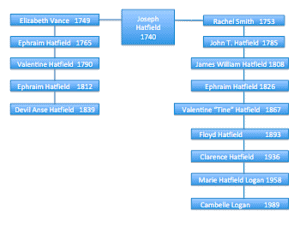
7 comments
Great piece on this notorious family. I have always been interested in this story and have watched and read a lot about these families. Thanks for the great writing and sharing you stories of your trip.
Unfortunately, this is a made up genealogy of Joseph. While Abraham, Jr did have a brother Joseph, he did not have a son, Joseph! This is proven in the will of Abraham, Jr, of which I hold a copy of original. At the writing of this will in 1742–two years after the proposed son, Joseph, was born, Abraham lists his nine children, with “the last seven being underage” and proceeds to name them–“David, Samuel, Elias, Jacob, William, Sarah, Phebe.” He also names his two sons of majorative age–“Abraham (III) and John.” Finally, he names his widow–Margaret. He was born and died in Elizabethtown, then Essex Co, NJ. He died, and his will was proven, without contest, in 1745. There was no Joseph at the time of his death, as this child, like the others, would have been named a guardian of his estate. Furthermore, when Margaret died in 1745, her will, also proven, names the same nine children–again no mention of a Joseph, with the last three sons–Elias, Jacob, William still being minors, therefore needing guardians. These legal documents leave no room for the Joseph supposedly born 1740.
I AM a direct descendant of the Feuding Hatfields. I appreciate your admiration of my family over the years, but your hillbilly and “bogged down in a feud over a stolen hog” remarks are a little offensive and short-sighted. There was much more to it than that. Maybe it’s to make you feel better about not being connected to them, maybe not. But I disagree with those remarks.
I am proud of my Heritage and the fact that my ancestors fought in what they believed in..I am proud to be considered a HillBilly…I can tell you right now that the feud between the two families was not over a pig..Another thing a true Hatfield runs from no one….
As a genealogist, I’ve always found the scandals and rifts to be the interesting part of a family tree. We have always thought that we were tied to the Hatfields and McCoys. It was so long ago, that no one feels any less of a person by the actions or “stories” of how things went down. You have interesting heritage and great stories for your family. My ggg grandfather and his entire family except for relations that were not present, was murdered by poisoning the lemonade at a Sunday dinner in 1850. As tragic as it was, I’m thankful to be here by chance. We all have our family skeletons.
We have Hartsfields and McElroys that go way back into Plymouth Rock and the very early settlers. Both names have been changed through generations to many various spellings. Both families seemed to migrate down to the Southern states and intermarried distant cousins etc. One researcher claimed that the Hatfields and McCoys were a group of families that branched off into the Blue Ridge mountains while others went further South into NC and Georgia. Nothing has ever been proven if there is a connection, however, the Hartsfields are said to have been Swiss and the name was originally Hartzfelder. Often names were spelled as they were pronounced….depending on the dialect. McElroy has MANY spellings including MacKilroy.
I watched the Movie from the Library with that famous actor, I can’t think of his name right now. I enjoyed the long movie and was surprised to see the similarities to the movie when I went on line with the Computer. The Hatfield’s seem to be more Affluent and got more Attention. As to the question I have been wondering for many years; Who was the bad guy and who was the good guy. I feel that they both were at fault for what happened. Yet the law here dose not remedy all feuds or injustices adequately. So they looked for justice on their own. Which is sometimes the only way to get it, so I can’t fault or condemn either side. I met a stucco contractor who claims to be a McCoy, I may call him this week to see what he has to say about the history of the Families. He claims to be a descendant of the feuding family of McCoy’s. It is very sad about Cotton Top. I was hoping that was a dramatization, but it seems that they really did Hang a Cotton Top. And that I did not agree with at all. Did any of the others ever get released from prison or did they die in state custody?